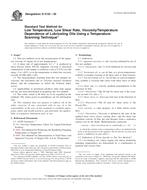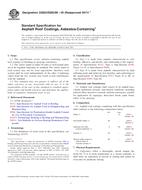1.1 This guide describes testing protocols for pyrophoricity, or combustibility characteristics, or both, of metallic uranium-based SNF. The testing will provide basic data for input into more detailed computer codes or analyses of thermal, chemical, and mechanical SNF responses. These analyses would support the engineered barrier system (EBS) design bases and safety assessment of extended interim storage facilities and final disposal in a geologic repository. The testing also could provide data related to licensing requirements for the design and operation of a monitored retrievable storage facility (MRS) or independent spent fuel storage installation (ISFSI).
1.2 This guide describes testing of metallic uranium spent nuclear fuel (SNF) in support of transportation (in accordance with the requirements of 10CFR71), interim storage (in accordance with the requirements of 10CFR72), and geologic repository disposal (in accordance with the requirements of 10CFR60). The testing described herein is designed to provide basic data related to the evaluation of the pyrophoricity/combustibility characteristics of containers or waste packages containing metallic uranium SNF in support of safety analyses (SAR), or performance assessments (PA) of transport, storage, or disposal systems, or a combination thereof.
1.3 Spent nuclear fuel that is not reprocessed must be emplaced in secure temporary interim storage as a step towards its final disposal in a geologic repository. In the United States, SNF, from both civilian commercial power reactors and defense nuclear materials production reactors, will be sent to interim storage, and subsequently, to deep geologic disposal. U.S. commercial SNF comes predominantly from light water reactors (LWRs) and is uranium dioxide-based, whereas U.S. Department of Energy (DOE) owned defense reactor SNF is in several different chemical forms, but is predominantly (80 % by weight of uranium) metallic uranium-based.
1.4 Knowledge of the pyrophoricity/combustibility characteristics of the SNF is required to support licensing activities for extended interim storage and ultimate disposition in a geologic repository. These activities could include interim storage configuration safety analyses, conditioning treatment development, preclosure design basis event (DBE) analyses of the repository controlled area, and postclosure performance assessment of the EBS.
1.5 Metallic uranium fuels are clad, generally with zirconium, aluminum, stainless steel, or magnesium alloy, to prevent corrosion of the fuel and to contain fission products. If the cladding is damaged and the metallic SNF is stored in water the consequent corrosion and swelling of the exposed uranium may enhance the chemical reactivity of the SNF by further rupturing the cladding and creating uranium hydride particulates and/or inclusions. The condition of the metallic SNF will affect its behavior in transport, interim storage or repository emplacement, or both, and therefore, influence the engineering decisions in designing the pathway to disposal.
1.6 The interpretation of the test data depends on the characteristics of the sample tested. The type and the size of the SNF sample must be chosen carefully and accounted for in the usage of the data. The use of the data obtained by the testing described herein may require that samples be used which mimic the condition of the SNF at times far into the future, for example, the repository postcontainment period. This guide does not specifically address methods for `aging’ samples for this purpose. The section in Practice C 1174 concerning the accelerated testing of waste package materials is recommended for guidance on this subject.
Product Details
- Published:
- 01/10/2000
- Number of Pages:
- 10
- File Size:
- 1 file , 130 KB


